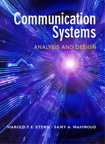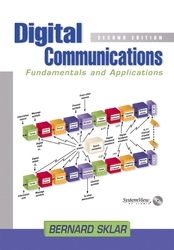Nonlinear Modulation Theory (Detection, Estimation, and Modulation Theory, Part II)
暫譯: 非線性調變理論(檢測、估計與調變理論,第二部分)
Harry L. Van Trees
- 出版商: Wiley
- 出版日期: 2003-01-10
- 售價: $1,450
- 貴賓價: 9.8 折 $1,421
- 語言: 英文
- 頁數: 368
- 裝訂: Paperback
- ISBN: 0471446785
- ISBN-13: 9780471446781
無法訂購
買這商品的人也買了...
-
 Object-Oriented Analysis and Design With Applications, 2/e
Object-Oriented Analysis and Design With Applications, 2/e$750$735 -
 C++ Primer, 3/e 中文版
C++ Primer, 3/e 中文版$980$774 -
 JPEG2000: Image Compression Fundamentals, Standards, and Practice (Hardcover)
JPEG2000: Image Compression Fundamentals, Standards, and Practice (Hardcover)$1,450$1,421 -
 Detection, Estimation, And Modulation Theory Part 1 (Paperback)
Detection, Estimation, And Modulation Theory Part 1 (Paperback)$1,700$1,666 -
 Detection, Estimation, And Modulation Theory .. Part 3 Edition (Paperback)
Detection, Estimation, And Modulation Theory .. Part 3 Edition (Paperback)$1,450$1,421 -
 OPtimum Array Processing Part IV of Detection, Estimation, and Modulation theory (Hardcover)
OPtimum Array Processing Part IV of Detection, Estimation, and Modulation theory (Hardcover)$8,450$8,028 -
 Thinking in Java 中文版 (Thinking in Java, 2/e)
Thinking in Java 中文版 (Thinking in Java, 2/e)$920$727 -
 LPI Linux 資格檢定 (LPI Linux Certification in a Nutshell)
LPI Linux 資格檢定 (LPI Linux Certification in a Nutshell)$880$695 -
 演算法導論 (Introduction to Algorithms, 2/e)
演算法導論 (Introduction to Algorithms, 2/e)$860$679 -
 Photoshop Color Correction
Photoshop Color Correction$1,930$1,834 -
 The CISSP Prep Guide: Gold Edition
The CISSP Prep Guide: Gold Edition$1,600$1,568 -
 JavaScript 範例活用辭典
JavaScript 範例活用辭典$450$351 -
 Digital Video and HDTV Algorithms and Interfaces
Digital Video and HDTV Algorithms and Interfaces$1,500$1,470 -
 近代密碼學及其應用 (Contemporary Cryptography and It's Applications)
近代密碼學及其應用 (Contemporary Cryptography and It's Applications)$540$486 -
 Java 完美經典優質學習篇
Java 完美經典優質學習篇$750$638 -
 ASP.NET 程式設計徹底研究
ASP.NET 程式設計徹底研究$590$466 -
 物件導向系統分析與設計:使用UML (Object-oriented Systems Analysis and Design Using UML, 2/e )
物件導向系統分析與設計:使用UML (Object-oriented Systems Analysis and Design Using UML, 2/e )$760$722 -
 重構─改善既有程式的設計
重構─改善既有程式的設計$720$569 -
 LDAP 系統管理 (LDAP System Administration)
LDAP 系統管理 (LDAP System Administration)$620$490 -
 Windows 程式設計 (Programming Windows, 5/e)
Windows 程式設計 (Programming Windows, 5/e)$990$782 -
 鳥哥的 Linux 私房菜-伺服器架設篇
鳥哥的 Linux 私房菜-伺服器架設篇$750$638 -
 鳥哥的 Linux 私房菜─基礎學習篇增訂版
鳥哥的 Linux 私房菜─基礎學習篇增訂版$560$476 -
 Quantum Computation and Quantum Information (Paperback)
Quantum Computation and Quantum Information (Paperback)$1,500$1,470 -
 人月神話:軟體專案管理之道 (20 週年紀念版)(The Mythical Man-Month: Essays on Software Engineering, Anniversary Edition, 2/e)
人月神話:軟體專案管理之道 (20 週年紀念版)(The Mythical Man-Month: Essays on Software Engineering, Anniversary Edition, 2/e)$480$379 -
 Probability and Random Processes: With Applications to Signal Processing and Communications
Probability and Random Processes: With Applications to Signal Processing and Communications$1,050$1,029
相關主題
商品描述
The respected classic, now in a handy paperback edition
Originally
published in 1971, Harry Van Trees' Detection, Estimation, and Modulation
Theory, Part II is one of the classic references in the area of nonlinear
modulation theory and analog communication. Highly readable and well organized,
it is as valuable today for professionals, researchers, and students interested
in the estimation of continuous waveforms as it was over thirty years
ago.
Part II focuses on the problem of finding the optimum estimate of a
waveform which is embedded in a signal in a nonlinear manner. The following
topics are covered in detail:
* Bayesian Cram廨-Rao bound on the mean-square
estimation error
* Optimum demodulators for frequency-modulation systems
*
Phase estimation: the synchronization problem
* Fokker-Planck techniques for
nonlinear analysis in the presence of noise
* Optimum angle-modulation
systems
* Rate distortion bounds for analog message transmission
* Analog
communication over randomly time-varying channels
* State variable analysis
procedures
For students in signal processing or professionals looking for
a reliable refresher on waveform estimation, Detection, Estimation, and
Modulation Theory, Part II provides authoritative, practical coverage by one of
the most renowned figures in the field. Although most current systems are
implemented digitally, the bounds on performance developed in Part II are still
applicable.
Table of Contents
Introduction.
Optimum Demodulators.
Phase Estimation: The Synchronization Problem.
Frequency Modulation.
Optimum Angle-Modulation Systems.
Comparison of Transmission Systems.
Nonlinear Estimation Theory: Alternative Approaches.
Analog Communication over Randomly Time-varying Channels.
Discussion.
Appendix: State Variable Analysis Procedures.
Glossary.
Author Index.
Subject Index.
商品描述(中文翻譯)
尊敬的經典著作,現在推出便捷的平裝版
《檢測、估計與調變理論,第二部分》最早於1971年出版,是非線性調變理論和類比通信領域的經典參考書籍之一。這本書可讀性高且組織良好,對於今天對連續波形估計感興趣的專業人士、研究人員和學生來說,與三十多年前一樣具有價值。
第二部分專注於尋找以非線性方式嵌入信號中的波形的最佳估計問題。以下主題將詳細介紹:
* 貝葉斯 Cramér-Rao 界限對均方估計誤差的影響
* 頻率調變系統的最佳解調器
* 相位估計:同步問題
* 在噪聲存在下的非線性分析的 Fokker-Planck 技術
* 最佳角度調變系統
* 類比訊息傳輸的速率失真界限
* 隨機時間變化通道上的類比通信
* 狀態變數分析程序
對於信號處理的學生或尋求可靠波形估計複習的專業人士來說,《檢測、估計與調變理論,第二部分》由該領域最著名的人物之一提供權威且實用的內容。儘管目前大多數系統是以數位方式實現,但第二部分中發展的性能界限仍然適用。
目錄
引言
最佳解調器
相位估計:同步問題
頻率調變
最佳角度調變系統
傳輸系統比較
非線性估計理論:替代方法
隨機時間變化通道上的類比通信
討論
附錄:狀態變數分析程序
術語表
作者索引
主題索引












